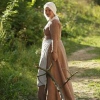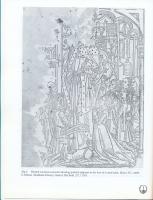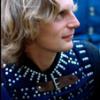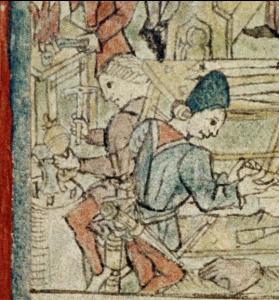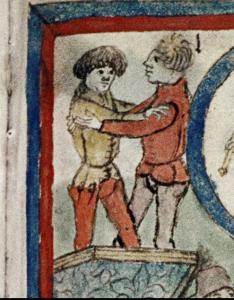Title [Henry vi King of England, with suppliants. mutilated, and with the inscriptions erased].
Publisher [England] : [s.n.], [ca.1490-1500]
Description Single sheet ([1] p.) : all ill. ; 370 x 240 mm
Notes "Henry VI, King of England, invoked as a saint. The king is portrayed with his crown, holding the sceptre in his right hand and the orb in his left, and wearing a mantle trimmed with ermine, standing on a carpet. He is positioned at the centre of an arch supported by pillars, which frame the picture, and surrounded by kneeling figures of smaller stature. At his feet the seated figure of a fantastic beast with serrated horns and tusks, to be identified as the antelope which Henry VI used as a badge. Two women and a man are shown kneeling to his right, three women and two men to his left. The man on the kings right has a rope round his neck. The woman kneeling in the foreground at his feet, on his left, holds a knife to her throat. The young man behind her is transfixed by an arrow. The second man on the kings left has a javelin protruding from his throat. All eight figures are raising their hands as in prayer, evidently invoking Henry as their intercessor. Behind the king a brocaded hanging, adorned with a shield displaying the quartered arms of England and France. On either side of the curtain votive offerings hang or are affixed to the wall: to the left,... a rosary, a taper, a naked figure and horse standing on a ledge, two legs (of a hanging figure?), and to the right a model ship, a chain, a shirt, a pair of crutches, and an inscribed tablet. There are two inscriptions, both almost totally lost through mutilation. All that remains of that above the frame are the letters cu (from Henricus?), and of that inscribed over the pavement at bottom mon d[:::]t (from Dieu et mon droit). Framed with a thick black line (preserved only in the right-hand margin). Dodgson, Grosjean, and Ettlinger have identified the supplicant figures as referring to specific miracles recorded after the death of Henry VI, as described in the Miracula postuma Henrici VI Angliae regis (ed. Grosjean). Henry VI, who was murdered in the Tower of London in 1471, came into particular favour during the reign of Henry VII (1485-1509), who built the chapel at Westminster Abbey in which he himself was to be buried with a view to the transfer of Henry VIs remains from Windsor, although this was never brought about. In 1490 an application was made for his canonization, and in 1494 Pope Alexander VI appointed an investigatory commission for whom the collection of Latin miracle stories, covering the years 1481-1500, appears to have been compiled. This is the context in which this unusual woodcut must have been executed, and the inclusion of the numerous ex votos in the image makes it certain that it was specifically associated with the cult of Henry VI in St Georges Chapel, Windsor Castle, where the remains of the martyr king long attracted pilgrimages.."--see: Coates (cited below)
For a complete description and list of references see: Coates, A., et al. A catalogue of books printed in the Fifteenth Century now in the Bodleian Library, Oxford, 2005.
Title from Bodleian Pre-1920 catalogue, added title from Bod. inc., imprint from STC.
Henry VI with suppliants. Woodcut with xylographic text--STC.
Chain-lines horizontal.
Printed in black ink in a press on one side of the paper.


